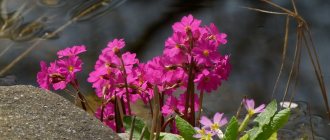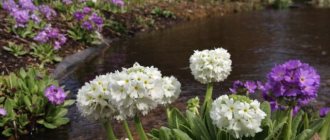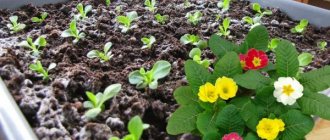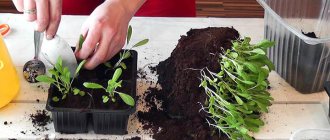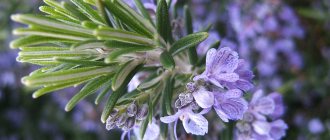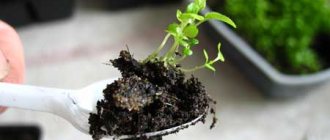Primrose or Primrose is a beautifully flowering small herbaceous perennial. Growing it from seeds allows you to get a new variety at home without spending a lot of money. If all the rules are followed, a healthy plant will grow with a long flowering period, not overfed and not infected with diseases and pests, as is often the case with store-bought ones.
The name comes from the Latin word “primus”, meaning “first”, which is also reflected in the Russian language. The plant blooms in early spring.
Description of the plant
The international name of this flower is primrose (lat. Primula). The genus Primulaceae, to which primrose belongs, is one of several members of the Primrose family. It contains at least 390 species, most of which grow in temperate climates. These are all herbaceous crops, including both annuals and perennials.
Common primrose (Primula vulgaris) is the most common garden primrose. The height of the plant is 10–30 cm. It is characterized by the presence of a rosette of leaves close to the ground, with a short stem in the center.
Botanical description of the genus Primrose:
- distribution area: temperate zones of western and southern Europe;
- in its natural environment it grows under bushes in deciduous forests, in clearings, roadsides, near railway tracks, in open pastures; in areas rich in humus, sometimes on stony loams;
- flowering: February - March;
- flowers: pale yellow with green veins; 2–4 cm in diameter, grow on thin stems;
- fruit: seed capsule;
- pollinators: insects;
- leaf rosette: basal;
- leaves: 5–25 cm long, 2–6 cm wide, wrinkled, gradually tapering towards the stem, with a jagged edge.
Find out more about the auricular primrose variety.
Cold stratification, or a simplified method of sowing primrose
Today, instead of freezing, a simpler stratification method is used - at low but positive temperatures. The growing process is accelerated, but the likelihood of success with this method is lower.
For primrose, two sowing strategies can be used without treatment with negative temperatures:
- With preliminary “swelling” of seeds outside the soil;
- Direct sowing in the ground with exposure first to warm and then to cold conditions.
It is better to pre-soak primrose seeds on a foam sponge cut into two parts (or with deep slits into which the seeds can be placed). The sponge is well moistened, the seeds are laid out on the surface, and then the second half of the sponge is covered on top.
Having placed such an “oasis” in a plastic bag or container, it is better to put it in the refrigerator for a week, at a temperature of 2 to 5 degrees Celsius, and ensure that the sponge maintains constant moisture. In a week or less, the primrose seeds will swell and can be sown in the substrate as usual. But you can use other strategies:
- soak primrose seeds in warm water or a weak solution of potassium permanganate for a day, and then place them in the refrigerator until they “pick”;
- spread the primrose seeds on a damp cloth and place under plastic wrap in a warm place for 2-3 days, then place in the refrigerator until the first signs of germination appear.
The swollen or beginning to hatch primrose seeds are laid out on the surface of the moistened substrate using a toothpick, wetting the tip in water and carefully prying up the seeds. There is no need to press them into the soil, but the crops need to be covered with glass or film as quickly as possible.
If you do not want to pre-soak, then sow the primrose seeds directly into the soil, let them swell in it, and then place the containers in cold conditions. The seeds are simply laid out on the surface of a well-moistened substrate and immediately covered with glass or film. For 4 or 5 days, the containers are placed in the warmest place so that the seeds swell (there is no need to wait for the sprouts to appear, this stage should take place in the refrigerator).
The bowl is transferred to the refrigerator and left in cold conditions until the sprouts begin to awaken and the first shoots appear. Containers with primroses are transferred to standard conditions for full germination.
There is an alternative strategy: put the containers with the crops in the refrigerator (or take them outside) only at night, and keep them warm during the day. Shock changes allow you to speed up the process of seed germination, but this strategy does not always work.
Sowing hybrid varieties of primroses: fine-toothed and ordinary
For primroses that do not require freezing and cooling of seeds, sowing is carried out according to the same principles as for freezing, but sown in moist soil. Next, the cooling stage is simply skipped and the plants are immediately moved to germination conditions.
Primrose seedlings. © Jane
Common types
There are at least 390 species of primrose in nature. In addition, breeders from different countries regularly grow new hybrids of these spring flowers, which are announced at annual flower exhibitions. Their catalogs also provide information on how to plant and care for the variety after purchase. If you select and plant several different primroses, you can have a bed with a longer flowering time.
Ordinary
Common primrose (Primula vulgaris) is a semi-evergreen perennial plant native to southern Europe and western Asia. Its pale yellow flowers bloom in early spring, just as the snow begins to melt. The plant grows well in partially shaded areas, shady gardens, along paths, under trees, along streams and wetlands. The flower is so common in livestock grazing areas that it does not need to be specially planted. But if you wish, you can collect wild plants from the meadow in the spring and plant them in your dacha or garden.
This is a compact, unpretentious plant, 10–15 cm high and 10–22 cm wide, with a rosette of leaves at the base. Their distinctive feature is the middle of a darker shade than the petals. These fragrant flowers will delight you until mid-spring.
The diameter of the yellow five-petal flowers is 2.5 cm.
Auricula
Primula auricula (lat. Primula auricula) is an evergreen perennial with leathery, often mealy foliage and simple, tray-shaped umbrella flowers, usually pink, purple or yellow. It grows on rocky soils in the mountains of Europe, including the western Alps, Jura, Vosges, Black Forest and Tatra mountains. In central Europe the plant is called mountain cowgrass or bear's ear because of the characteristic shape of the flowers.
Important! Primrose soil can be a little drier in the summer, but it should never dry out completely. These plants cannot tolerate summer heat.
Auricula is distinguished by its rich color, bright shades and delicious aroma. Flowering will last from mid-March to April. The plant can be planted with seedlings or seeds. Primroses grow well in open ground, greenhouses and in pots on the windowsill. The height of the flowering plant is 15–45 cm. To date, thousands of indoor varieties based on this species have been obtained.
Caring for them after purchase is no more difficult than caring for wild primroses.
Hairy
Primula x pubescens is a hybrid. The parent species were P. auricula and P. hirsuta (P. rubra). This is a plant with bright 5-petaled flowers that grow up to 30 cm in height. Originally, the plant was characterized by pink-crimson flowers, but now many varieties with other colors have been developed, including yellow, pink, red, purple and white shades. Flowers appear in groups (umbels) at the tops of stems rising from a basal rosette. Flowering begins in mid-April and lasts until mid-May. The leaves of the primrose are leathery, oblong, and green in color.
It can be planted in pots and in open areas. Prefers moist, well-drained soils. It tolerates shade, but it is better to choose a sunny area for the primrose. Suitable for rock gardens and flower beds. It is recommended to propagate by division after the flower has faded.
Fine-toothed
Primrose (Primula denticulata) is one of the easiest species to grow and adapts well to most climate conditions. Grows throughout Southeast Asia. The plant forms a rosette of large, oblong-oval green leaves, at the ends of which grow vertical stems with a ball of flowers. The diameter of this spherical inflorescence reaches 10 cm, and the height and width of the primrose itself are 30 cm.
Important! Usually primroses that you buy by March 8
are
annual plants (Primula × polyantha).
They won't be saved until next year. Color varies from white to shades of pink, purple, and blue. The flowers have a delicate aroma and are suitable for cutting. Flowering continues from mid-April to the end of May. A distinctive feature of the species is its large size and thick peduncles. In some varieties they reach a height of 60 cm. The plants prefer evenly moist soil and grow well next to a pond or stream. In cool conditions they retain their attractiveness even under bright sun. But you need to make sure that the soil is constantly moist.
High
High primrose (Primula elatior, oxlip) is one of the most convenient varieties. It can thrive in soils that are low in nutrients, but they must be rich in calcium. The species is distributed throughout Europe and is even found on the Kola Peninsula. Grows in damp forests and meadows.
This is a herbaceous perennial, the rosette of which grows to a diameter of 25 cm, and peduncles to a height of 30 cm. In spring, light yellow flowers appear on a high stalk. There will be 10–30 clusters of them together on one stem. The width of each flower is 9–15 mm. The light green tube-shaped calyx has darker green ribs. The flowers open wide and are characterized by facing in one direction.
In appearance, the appearance is very similar to the spring primrose (Primula veris), but the difference is that the tall primrose has larger flowers. The leaves are dark green, oval-shaped, wrinkled. They grow in the form of a basal rosette and have long cuttings.
Cortusoid
Primula cortusoides (lat. Primula cortusoides) is a very common species in the territory from the Urals to China. This original plant has delicate clusters of pink, star-shaped flowers with yellow eyes that bloom in mid-spring. The small, toothed leaves are collected in a rosette and remain bright green throughout the season.
Important! Primrose cortuside is listed in the Red Book and picking it is prohibited.
Cortus primula grows up to 30 cm in height. Its flowers rise on stems at least 20 cm high. If you intend to create a carpet of plants, then plant them at a distance of 15 cm from each other. The characteristic feature of foliage is that it remains, as it were, pressed to the ground. Under ideal conditions, the plant can live and bloom for about 5 years. It is best grown in partial shade with evenly moist soil. The species is tolerant of urban pollution, but this shortens its lifespan.
Julia
Primula Juliae (Primula juliae) is a species discovered by Julia Mloskosevich, the daughter of the Polish aristocrat, botanist Ludwig Mloskosevich, in the Eastern Caucasus in the Tiflis region around 1900. The plant is characterized by its bright purple color, miniature size and hardiness. The height of the plant does not exceed 10 cm. Primrose Julia has a small basal rosette, round jagged leaves of a light green hue and crimson flowers. They consist of 5 petals, similar to hearts, and a small yellow center.
Find out more about the primrose variety Ballerina.
Currently, this species is listed as rare or endangered in most of Russia. Since the discovery of the first plants, many new varieties have been obtained from them by crossing with other species. But during the Second World War, many of the original varieties were lost, so it is almost impossible to find Primula juliae in its original form.
Orchid
Orchid primrose or vial primrose (Primula vialii) grows in wet meadows and near bodies of water in the south and west of China. It is a herbaceous perennial plant that grows up to 40 cm. At the beginning of development, its flowers look like narrow green spikelets that turn red and then open pink from the base upwards, so they appear two-colored. The active growing season lasts from May to September inclusive. Flowering begins in June and ends by the end of July. Transplantation is recommended from September to November.
This species is excellent for growing with ferns in partly shaded and well-drained areas. It can be planted en masse near artificial reservoirs. And in this case, shading is not necessary, since it is compensated by increased humidity.
Mealy
Powdery primrose (Primula farinosa) is a perennial native to northern Europe and Asia in moist meadows. Its height is 3–20 cm. The leaves are located in basal rosettes; they are oblong, lanceolate, up to 10 cm long, up to 2 cm wide. The upper part of the leaf blade is smooth, and the lower part seems a little powdery. This is where the name of the species comes from - mealy.
Did you know? Japanese primrose ( Primula japonica)
-
the owner of an extremely original “candelabra” peduncle.
The flowers on it are arranged in several tiers. The purple-blue flowers of Primula farinosa appear in early spring in a rounded cluster of a dozen atop thick stems. Each flower has 5 heart-shaped petals.
Frost stratification, or the classic method of sowing primrose
If you want to use the classic and most reliable method, then sow only on dry soil and superficially. The seeds cannot be covered on top with even a thin layer of sand or sifted substrate: they just need to be pressed into the soil, but not too hard, but only secured. Sometimes it is recommended to sow in the snow; it can simplify the process itself and help the seeds to “get involved”.
The optimal sowing density for primrose can be a critical parameter; errors in density are immediately felt at the stage of growing young seedlings. Primrose seeds are not spread out thickly, so that no more than 5 seeds fall per 1 square centimeter of soil. Despite their small size, it is better not to mix primrose seeds with sand and spread them out manually, using a toothpick or tweezers.
After sowing, do not spray the seeds from above. The containers just need to be covered with film or glass. But don’t rush to take the containers to the windowsill: the germination strategy for primrose is special.
Containers covered with film or glass with sown primrose seeds must be sent for stratification. It is considered optimal to keep it in temperatures from -5 to -10 degrees for at least 10 (and ideally 20-30) days. A freezer is quite suitable for primrose, but you can simply put the containers outside (if the weather is frosty, watch for thaws), or bury them in a snowdrift or garden.
Primrose seedlings grown from seeds. © Jane Hoehoegrow
Garden care from the moment of planting in open ground
Primroses are considered outdoor plants, although they can also be grown in pots indoors. If we are talking about indoor primroses, then you need to remember that after they bloom, they need to be taken out of the room and placed in a protected place in the summer garden or on the terrace. In the spring, the plants will “wake up” on their own, and when they bloom, they can be brought into the building. They will need a bright sunny window sill, but in such a way that direct sunlight does not fall on them.
Did you know? Primroses have their own special holiday. April 19th is Primrose Day in the UK.
For plants in the garden, a number of conditions must be met:
- Organize the right combination of light, water and nutrients. Most varieties will thrive if they are exposed to mild sun in the morning and shaded in the afternoon.
- The air temperature should be moderate - no higher than +15°C. Extreme heat will cause wilting.
- Need nutrient-rich, moist soil. Good drainage is also required, otherwise the plant will begin to rot.
- Feed with weak fertilizers during flowering. 1-2 times per season is enough.
Watering
For normal life, the flowers in question need moisture: if there is a lack of it, the plant will wither, and if there is too much, it will begin to hurt. Primroses also need soil that is moist. If, when you touch the soil with your finger, you do not feel moisture, it means it’s time to water. But do not allow moisture to get on the leaves - this contributes to the proliferation of phytopathogens and primrose diseases.
Water especially often in August. At this time, the flower buds of the next season are being laid and the plant definitely needs a lot of water. Watering outdoor plants is stopped just before frost.
Important! If water from a city water supply is used for irrigation, it must be settled to reduce the amount of chlorine ions. It is harmful to plants.
Top dressing
Fertilize primroses in early spring . They need a balanced fertilizer, in which nitrogen, potassium and phosphorus are in equal proportions. For example, 10x10x10, 14x14x14 or 5x10x5, where the dose of potassium is increased for the development of the root system. Two-color primroses consume the most fertilizer. They need to be fertilized 2 times per season: in early spring and in July after flowering.
In soils with high pH (alkaline soils), additional iron or sulfate must be added to reduce chlorosis (yellowing) of leaves. Yellow foliage can also be caused by a lack of nitrogen in the plant. Both can be corrected by feeding with appropriate fertilizers.
Trimming
At the end of winter, after the last frost, dry leaves and stems are removed from the flower garden. After this, there is no need to trim anything until the first half of summer. In the fall, at the end of the season, gardeners do not recommend removing anything, since the leaves become a covering layer and protect the roots from frost.
Did you know? In the Middle Ages, primrose was used to treat paralysis, gout and rheumatism. This flower was also part of alchemical rejuvenating potions.
How to prepare a plant for winter
Most varieties tolerate frosts down to -30°C well and do not require shelter for the winter. But if the winter has little snow, then in order to protect the roots from low temperatures, the plants can be covered with a layer of mulch. This can be bark, pine needles or chopped straw.
If primrose is grown indoors, then the pots with it are taken out of the room immediately after they bloom (in July). This plant is not intended for long-term indoor use. In winter, they can be taken to the basement or any other room where the temperature will not exceed +8...+12°C. It is imperative to provide them with watering 2 times a month, since in completely dry soil the root system may die.
Diseases and pests
Like other garden flowers, under unfavorable climate conditions or poor care, primrose can be subject to the harmful effects of various fungal diseases and parasites. Of the first, the culture is most often affected by:
- powdery mildew - appears in the form of brown spots with a white coating formed on the leaf plates;
- gray rot - easy to recognize by the presence of yellow spots with a brown edge on the leaves and shoots;
- rust - red-brown spots form on the outer surface of the leaves, which later transform into tubercles;
- anthracnose — the infected parts become covered with an almost black coating and small brown spots with a purple edging;
- chlorosis - primrose leaves become colorless, buds become deformed, and flowers slow down their growth.
If a crop becomes infected, all affected parts should be cut off and destroyed . Next, the bushes must be sprayed with fungicidal preparations, for example, Topaz. Also, for prevention, you can treat the plantings with a solution of Bordeaux mixture.
Of the pests, the flower most often becomes a “victim”:
- slugs;
- spider mite;
- nematodes;
- weevil.
Modern insecticidal preparations - Actellik, Ragor, Aktara - can effectively fight insects . The leaves of the plant and shoots should be thoroughly washed with soapy water. Experts advise collecting slugs by hand and burning them outside the site.
Primrose is a delicate, beautiful and bright flower that attracts gardeners not only with its long-lasting lush flowering, but also with its ease of care and cultivation. The flower is not capricious, easily reproduces, quickly adapts to a new place, however, it is quite demanding on soil moisture, which is extremely important to consider when growing it.
Reproduction
When planting primroses in your home plot, you need to pay attention to the distribution area of the variety. Here we can distinguish 2 large groups: those that grow on swampy soils, and those that grow on rocks. The first need humus-rich, moist areas, and the second need dry areas. Reproduction of flowering plants is possible in several ways. All of them can reproduce by seeds, and in the natural environment this is the only method of reproduction.
At home conditions are also available:
- dividing the bush;
- planting seedlings;
- cuttings
You need to divide old bushes that are over 3 years old. They are easy to notice by the fact that the rosette may have several growing points and many small leaves. Seedlings are grown in early spring from seeds harvested in summer. Cutting is planting a primrose leaf in the soil for rooting. Once this happens, the plant will create a new growing point and the first leaves will appear from it next to the leaf you planted. Expect the first flowering in the second year after planting. Primroses are hardy and should survive the winter well.
Dividing the bush
The division of the bush is carried out in August or early autumn - after the plants have flowered and the active growing season has ended. Such an event should be held every 3-4 years.
Different approaches to sowing primroses
All primroses, except fine-toothed and ordinary, as well as some hybrid varieties, require not quite the usual treatment after sowing - cold stratification. But there are several strategies for treating the seeds of these plants with cold, and they are radically different. Primroses can be stratified either at low negative temperatures or in a more gentle mode. Accordingly, there are two main strategies for growing seedlings:
- Classic method with a frost phase.
- A simplified method with treatment at low positive temperatures.
If you do not have the opportunity to place containers with soil in the refrigerator, then at least place the seeds themselves in the freezer for at least 12 hours. In this case, cultivation is similar to primroses without stratification.
To avoid unnecessary hassle, carefully study the recommendations on the package of seeds for hybrid primroses: if they do not need stratification, then doing it is just a waste of time, which will not affect the germination of the seeds. Your success will depend only on their quality.
Picking primrose seedlings grown from seeds. © auff
Landing rules
Schefflera propagation: interesting methods and examples of planting
Primrose is usually grown in small plastic pots, but in the summer it is often transplanted into open ground. Then you need to replant the bush into a flowerpot and bring it indoors.
Step-by-step algorithm for planting a flower:
- Choose the right place. The plant should not be planted in an open space with partial shade.
- Prepare the correct substrate and prepare material to create a drainage layer.
- It is necessary to prepare small holes that will be suitable in size for the size of the root system.
- If you plan to plant several specimens, the distance between the holes should be about 30 cm.
- Place a layer of drainage at the bottom of the hole, the height of which is about 1-1.5 cm.
- Using a spray bottle, moisten the soil in the hole.
- Sprinkle the drainage layer a little with the prepared substrate.
- Place the bush in the hole and sprinkle with the rest of the substrate.
- There is no need to press down the soil, since the root system should be well enriched with oxygen.
- Using a sprayer, moisten the top layer of soil again.
Landing algorithm
Primrose seedlings, which were previously grown at home in containers, are also planted in the same way.
Note! If you plant the plant later, the specimen will be able to survive and even develop, but it will take longer to recover and take root.
Growing primrose seedlings
The slow development of primrose seedlings is the main reason that plant picking is carried out quite early: seedlings in a common container are grown only until the first full leaf appears (in the strongest first shoots, by the time the first leaf is released, the rest may also develop a second one). Until this time, the main task is careful watering.
The plants are sprayed with a fine spray bottle, evenly moistening the soil and trying not to soak the sprouts themselves too much. The substrate, as in the germination stage, must be constantly moist, but not soggy. Drying out the soil is destructive.
Primrose seedlings. © Ray Molin-Wilkinson


